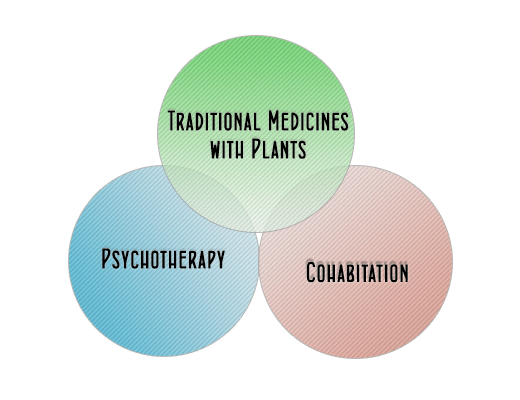Therapeutic Triad

The foundation of Takiwasi's addiction treatment model is based on three core tools and principles, that are connected and support each other:
1º: Traditional Medicine and Plant Intake
It is one of the central axes of the treatment. It includes the use of:
- Depurative plants: plants that can cause vomiting are used. This can be an unpleasant effect but they are very useful for physical detoxification, emotional discharge and mental clarity.
- Containment plants: they promote reconnection with emotions, memories, dreams and the integration of psychological information.
- Master plants: traditionally used by the healers of the area, they are offered in a totally individualized way, depending on the characteristics of each person. They are used to balance their personality and reinforce healthy psychological and physical structures.
Plant intake sessions are always conducted in a ritualized context and are divided into: sessions with depurative plants, diets (retreat in the jungle) and ceremonies of Ayahuasca (master plant and ancestral discovery of Amazonian indigenous people). The taking of plants comes into synergy with the psychotherapeutic work carried out in parallel.
2º: Cohabitation, Everyday Life and Ergotherapy
This work has clear therapeutic meaning. This does not just mean taking on productive work. Rather it is seeking to generate awareness of one’s personal attitudes, and to gain clarity on maladaptive patterns that addiction has strengthened. Such activities are designed for the patient to develop or strengthen pro-positive and pro-active behaviors, assume personal commitments, claim their responsibility and assimilate social and personal values that drug use has disrupted. In this way they cultivate healthy habits and healthier lifestyle choices for themselves and their family.
It is in this space where tools are taught in various workshops, and individual and group interventions and dynamics assessed. It is where simple and fundamental aspects such as habits, tolerance to frustration, problem solving and behavioral characteristics are analyzed. Specific tasks are restructured and developed until they are completed, and this offers a therapeutic space for one to contemplate and re-evaluate life and decisions.
3º: Psychotherapeutic Intervention
This is done from several existing approaches: Cognitive Behavioral Psychotherapy, Psychodynamics, Humanist, Psychodrama, Bioenergy, Body, Gestalt, etc. Given the complexity of the human beings, we do not standardize interventions. Each patient is considered individually, and is given their appropriate type of intervention for their specific problem.
Each therapist will support people through medicinal plant intake sessions and daily life with psychotherapy. Any emotions, thoughts and dream material from master plant sessions are processed or analyzed in the light of modern psychotherapy to help people integrate their experience and heal.
This highlights one of the most important points in Takiwasi: the integration between traditional healing medical knowledge, Western medicine, and academic psychology.
Contact Form
×A confirmation e-mail has been sent to your account.